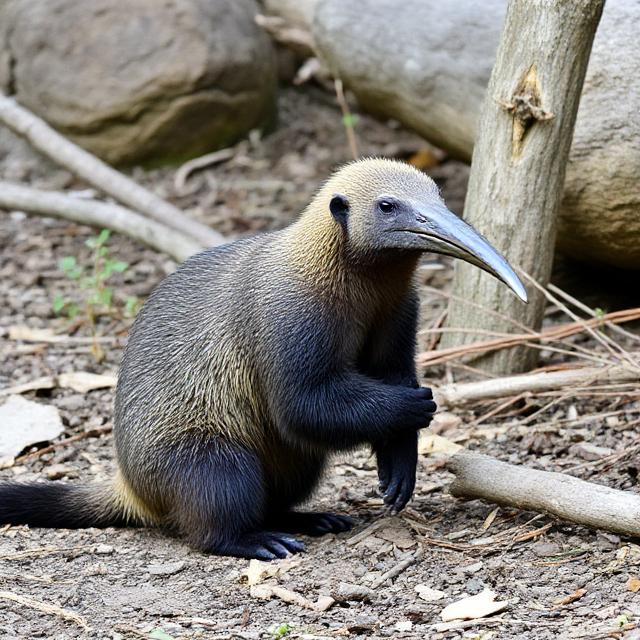Here’s a comprehensive overview of the Anteater, a unique and specialized mammal known for its long snout and insect-eating habits:
🐜🐻 Anteater: General Overview
Anteaters are insectivorous mammals native to Central and South America. Known for their elongated snouts, sticky tongues, and powerful claws, they specialize in eating ants and termites. They belong to the order Pilosa, which also includes sloths.

🔬 Classification
- Kingdom: Animalia
- Phylum: Chordata
- Class: Mammalia
- Order: Pilosa
- Suborder: Vermilingua (“worm tongue”)
- Families & Genera:
- Myrmecophagidae: Giant Anteater (Myrmecophaga tridactyla), Northern & Southern Tamandua (Tamandua mexicana, Tamandua tetradactyla)
- Cyclopedidae: Silky Anteater (Cyclopes didactylus)
🧬 Species of Anteaters
- Giant Anteater – up to 7 feet long including tail
- Northern Tamandua – smaller, tree-dwelling, found in Central America
- Southern Tamandua – similar to Northern, South American forests
- Silky Anteater – tiny, arboreal, nocturnal, lives in treetops
🐾 Physical Characteristics
- Size:
- Giant Anteater: 6–7 ft (1.8–2.1 m) including tail
- Tamanduas: ~2–3.5 ft (60–90 cm)
- Silky Anteater: ~14 inches (35 cm)
- Weight:
- Giant Anteater: up to 90 lbs (41 kg)
- Tamanduas: 4–15 lbs (2–7 kg)
- Silky Anteater: ~0.5 lbs (200 grams)
- Color: Gray, brown, or golden-yellow with black markings
- Distinct Features:
- Long snout with small mouth
- Sticky tongue (up to 2 ft long in the giant anteater)
- Strong forelimbs with large claws
- No teeth (edentulous)
🌎 Habitat
- Range: Central and South America (from Mexico to Argentina)
- Habitats:
- Grasslands and savannas (Giant Anteater)
- Tropical and subtropical forests (Tamanduas, Silky Anteater)
- Arboreal (Silky & Tamanduas), terrestrial (Giant Anteater)
- Shelter: Hollow logs, trees, or dense vegetation
🍽️ Diet
- Type: Insectivore
- Main Foods: Ants and termites (can eat up to 30,000 insects a day!)
- Feeding Method:
- Use claws to tear open nests
- Sticky tongue flicks in and out up to 160 times per minute
- Avoids destroying entire colonies to allow recovery
- No Chewing: Tongue delivers insects to the stomach, which grinds food
🧠 Behavior
- Activity:
- Giant Anteater: Mostly diurnal
- Tamanduas & Silky Anteater: Nocturnal and arboreal
- Social Structure: Solitary
- Territoriality: Scent marking and avoidance behavior
- Defense: Curl into a ball or stand on hind legs to slash with claws—can seriously injure predators
🍼 Reproduction
- Mating Season: Varies by species and region
- Gestation:
- Giant Anteater: ~6.5 months
- Tamanduas: ~5 months
- Offspring: 1 pup; rides on mother’s back for several months
- Parental Care: Mother carries and nurses young, especially in tamanduas
🛡️ Conservation Status
- Giant Anteater: Vulnerable (IUCN Red List)
- Tamanduas and Silky Anteater: Least Concern, but declining in some areas
- Threats:
- Habitat loss (deforestation, agriculture)
- Roadkill
- Hunting (for bushmeat or retaliation from farmers)
- Fires in savanna habitats
- Conservation Efforts: Protected areas, awareness campaigns, and road mitigation measures
🎉 Fun Facts
- The giant anteater’s tongue can flick in and out over 150 times per minute!
- Despite being toothless, anteaters have extremely muscular stomachs to grind food.
- Giant anteaters are poor climbers but excellent swimmers and can cross rivers with their long snout above water.
- Tamanduas emit a foul-smelling odor from their anal glands, earning them the nickname “stinkers of the forest.”
- Silky anteaters are the smallest known anteater species and one of the least studied.